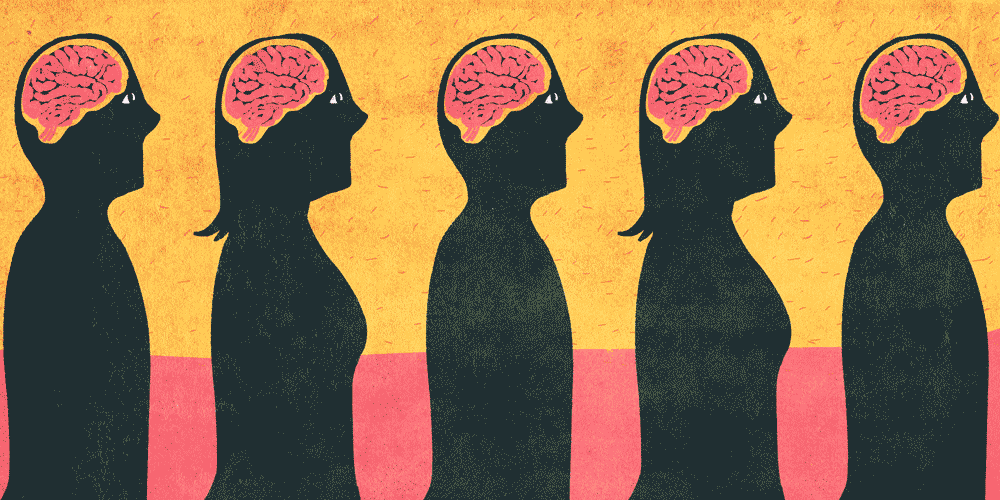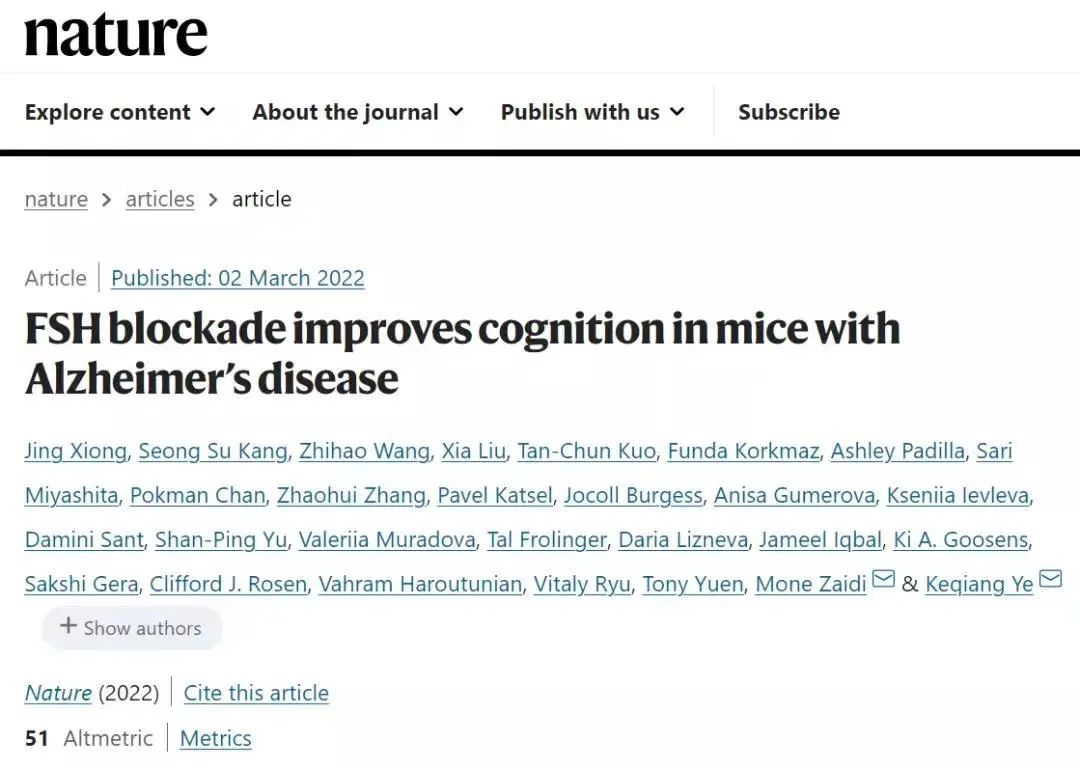
According to the 2021 World Alzheimer’s Disease Report, more than 55 million people worldwide suffer from Alzheimer’s disease (commonly known as “senile dementia”).
“Memory decline” is only an early symptom of dementia. As the disease develops, it will slowly deprive a person of his ability to take care of himself in life, “tamper” with his personality, and keep his emotions out of control…

According to an epidemiological survey in the United States, about two-thirds of dementia patients are women.
Why do women have a higher risk of Alzheimer’s than men? A recent study published in the journal Nature has the answer.
Why are women more prone to dementia?
Tau protein and β- Amyloid protein is a protein that accumulates and accumulates in the brain of patients with Alzheimer’s disease.
Both men and women are affected β- When tau protein begins to accumulate, memory dysfunction will appear.

The research results published in the journal Nature revealed for the first time that follicle stimulating hormone (FSH) is the reason why elderly women are more likely to suffer from Alzheimer’s disease, and provided a new scheme for early screening and intervention of the disease.
FSH can directly act on hippocampal and cortical neurons and accelerate β Amyloid protein and tau protein precipitate and press the “accelerating key” for the pathological development of Alzheimer’s disease.
In the perimenopausal period of women, the content of FSH in the body rises sharply to more than 10 times, while the level of FSH in elderly men is about 3 times higher than that in young men.
A study published in the Journal of brain science by Lund University in Sweden also found that the accumulation rate of tau protein in women was 75% higher than that in men in the early stage of the disease, which also explained why women developed Alzheimer’s disease faster than men.
Alzheimer’s disease is divided into six stages
Alzheimer’s disease is a continuous pathophysiological process, with a time span of several decades. The whole process can be divided into six stages.
Phase I: asymptomatic
At this time, if we detect the biomarkers of Alzheimer’s disease, we will find a large number of β Amyloid protein is deposited in the cerebral cortex.
Phase II: preclinical stage
Subjective cognitive decline (SCD) stage. Brain cells are degenerative and necrotic, but the degree of injury has not exceeded 50%. Under the compensatory effect of cognitive reserve, there will be no decline in cognitive function, but the patients will feel it.
This feeling has nothing to do with acute events, and the objective examination cognition is within the normal range. Patients sometimes have anxiety, depression and minor mental and behavioral abnormalities, such as theft delusion.
Phase III: mild cognitive impairment
Recent events cannot be remembered, and distant events cannot be forgotten. Brain compensation has disappeared and objective damage has been caused. As the hippocampal region shrinks, it cannot encode, store and extract memory, and loses the ability to learn, so it can’t remember the recent events.
For example, I forget what I just said and can’t remember what I just did. The long-term memory was not affected, and the patients preferred to recall the “courage of that year”, trying to cover up the embarrassment of not remembering new things.
This stage lasts from one year to three to five years.
Phase IV: mild AD dementia stage
Time orientation disorder. The patient’s concept of time began to disappear and could not remember what time it was now.
Phase V: moderate AD dementia stage
Place perception confusion. Lost after going out, and even went to the toilet at night, I couldn’t find the bedroom. At this time, another characteristic of patients is the loss of a sense of disease. They do not admit that they have memory problems and always try to cover up with various excuses.
For example, he refused to admit that he couldn’t work out a simple calculation problem, insisting that “this is for primary school students, I don’t do it”; If you forget where to put things, you have to say that others stole them, and there is an obvious delusion of being stolen and killed.
Phase VI: severe AD dementia stage
Character orientation disorder. If the medication is not standardized, the condition will enter the severe stage after 1 ~ 3 years of moderate cognitive impairment.
Patients began not to recognize their loved ones, even themselves in the mirror. If it continues to develop, the brain will lose control of the body, and there will be serious problems such as unable to brush teeth and swallow.
12 controllable risk factors of obsession
Alzheimer’s disease is a degenerative disease of the central nervous system. Once clinical symptoms appear, it will be irreversible.
Therefore, early intervention is very important. If measures can be taken before symptoms appear, you can press the pause key to control the disease without progression for life.
A paper published in The Lancet in 2020 listed 12 controllable risk factors.
Researchers believe that as long as these factors are effectively controlled, it is possible to prevent or delay up to 40% of dementia cases. Specifically:
A low level of education in the early years increases the risk by 7%
Middle age increased the risk of hearing impairment by 8%, brain injury by 3.4%, hypertension by 1.9%, excessive drinking by 0.8% and obesity by 0.7%
In later years, smoking increased the risk by 5.2%, increased the depression by 3.9%, increased the social interaction by 3.5%, increased the exercise by 1.6%, increased the risk of diabetes by 1.1%, and increased the risk of air pollution in the environment by 2.3%.
其中,最要关注的是3项:早年受教育差、中年失聪、晚年吸烟。
Among them, three items should be paid most attention to: poor education in the early years, middle-aged deafness and smoking in the later years.
Self rated cognitive function
Preclinical stage is the key period to discover Alzheimer’s disease in time. When the clinical characteristics of subjective cognitive decline (SCD) appear, we should pay attention to it, see a doctor as soon as possible and check amyloid protein.
Seven clinical features of SCD
1. Self perceived memory decreased.
2. This feeling has appeared in the past five years.
3. This feeling occurs at the age of 60 and above.
4. I’m worried about this feeling and fear of dementia.
5. This feeling persists.
6. After taking the initiative to see a doctor because of this feeling, even if the initial scale screening is normal, check the scale once a year to see if the change trend continues to decline.
7. Informed persons, such as relatives and nannies living together for a long time, confirmed that the patient’s memory decreased or mild mental and behavioral abnormalities.
Among them, Article 4 is the most important. As long as you have concerns, you should attach great importance to it.
You can also make a self-test questionnaire of subjective cognitive decline. If the final score of people aged 60 ~ 80 exceeds 5 points, it is recommended to go to the memory specialist clinic or relevant departments of the hospital.
Anti aging addicts have the best diet
In 2021, mind diet was selected as the fifth best diet in the list due to “brain protection”.
A study of healthy residents in the Chicago area found that people who stick to the mind diet have 7.5 years younger brains than those who don’t.
A study at the University of South Wales in Australia showed a 19% reduction in the risk of mild dementia or cognitive impairment.

How to eat mind diet? In this diet mode, 15 kinds of food are very important. Specifically, encourage to eat more of 10 kinds of food and eat less of 5 kinds of food as far as possible.
10 Foods That Encourage More Eating
Green leafy vegetables: to eat every day, such as spinach, rape, cabbage, etc.
Non-leafy green vegetables: It’s best to choose non-starchy vegetables that are nutrient-dense but lower in calories, such as tomatoes and cauliflower.
Berries: Eat berries at least twice a week, including strawberries, blueberries, raspberries, etc.
Nuts: At least 5 servings of nuts per week, one serving is about 10 grams, about 10 walnuts. It is recommended to switch nut types from time to time to get more nutrients.
Olive oil: It is recommended to use olive oil as the main oil for cooking. If you are not used to it, you can use camellia seed oil instead.
Whole grains: Eat 3 servings (90 grams) of whole grains per day, such as oatmeal, quinoa, brown rice, whole-wheat flour, and 100% whole-wheat bread.
Fish: Eat fish at least once a week, and recommend sardines, trout, and tuna rich in unsaturated fatty acids.
Beans: Eat beans at least four meals a week, including all beans, such as lentils and soybeans.
Poultry: Eat poultry such as chicken and duck at least twice a week, but not fried chicken.
Wine: No more than one glass a day is recommended, although this is controversial. Don’t start drinking if you haven’t had a drinking habit before.
5 foods that encourage eating less
Butter: Recommended daily intake of less than 14 grams.
Cheese: Have up to once a week.
Red meat: No more than 4 palms (including thickness) are recommended per week.
Fried foods: Especially fried foods made in fast food restaurants, eat at most once a week.
Pastries and sweets: Refined foods and sweets such as ice cream and cookies are not recommended.
The biggest feature of the MIND diet is that it is easy to implement, and it works even if it is not strictly implemented.
Anyone who wants to keep their brains young, or has a family history of Alzheimer’s, can try this eating pattern. As long as you follow the above principles and think for a few more minutes when you usually eat or order takeout, you can stay away from Alzheimer’s.



Comments